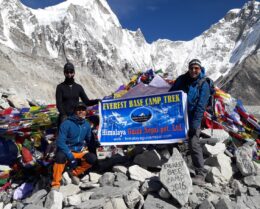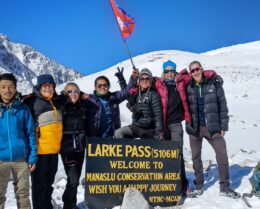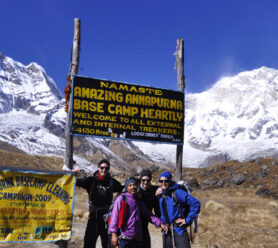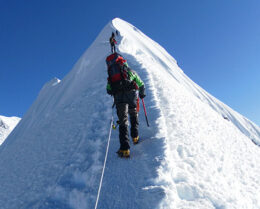Thrilling Adventure in Everest Base Camp
UPDATED ON 16 February, 2024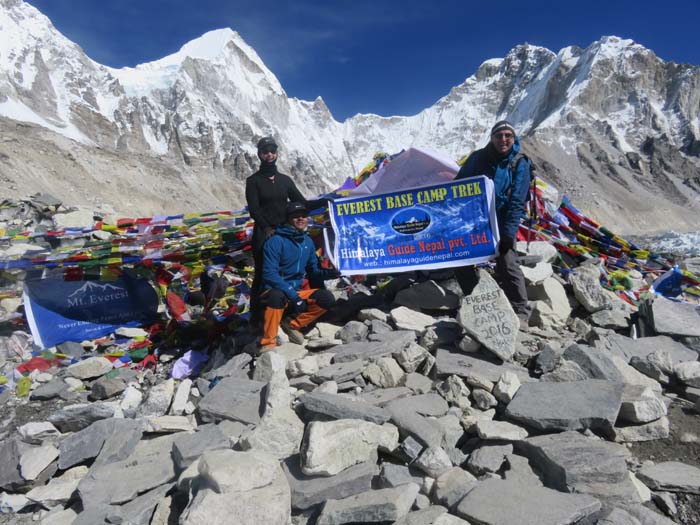
The Everest Base Camp has been a chief attraction for trekkers and those who seek adventure in general since 1953, mainly because the region is home to Mt. Everest 8,848.86m the tallest peak in the world. The extravagance of the region has only grown evermore popular with time, as more and more people seek the thrill of visiting this remarkable piece of natural architecture.
The region is also home to several stunning attractions such as Kala Patthar 5,550 M an attendant peak that offers a magnificent view of Mt. Everest and the snowy peaks above the Khumbu glacier, Khumbu icefall, and Imja glacier, all of which complement the natural beauty of the peak.
The region is also rich in cultural heritage, being home to the Sherpa people of Solu (below Lukla) and Khumbu (above Lukla) as well as Buddhist culture itself. Monasteries, Sherpa bazaars, and villages decorate the route as you experience native Buddhist culture firsthand during your journey toward the premier peak of the Himalayas.
Namche Bazaar 3,440 M which is the unofficial capital of the Khumbu region is a key trading post among the Sherpas and is abundant in restaurants, shops, lodges, and internet cafes.
The Khumbu region is home to Sagarmatha National Park, a world heritage site. Experience the extravagance and beauty of the world’s tallest peak firsthand as you embark on the journey of a lifetime.
During the trek, you can also climb trekking peaks Island and Lobuche including in the same itinerary, and Gokyo Valley on the other side.
Everest Base Camp Trek Itinerary

The Everest Base Camp trek itinerary is a moderate one, as it lasts for only 12 days. During this time, the trekkers walk for around 9 days.
Almost two days are assigned for acclimatization in the journey. The places that the trekkers cover during the journey are Dingboche, Monjo, Lobuche, Gorak Shep, Pheriche, and so on.
The Everest Base Camp trek itinerary doesn’t just allow you to cover these settlement areas, but also the numerous attractions, natural, cultural, religious, and so on.
One of the best things about this Everest Base Camp trek itinerary is that you can modify it to cover the settlement areas and attractions that are not on the main route.
One of the significant locations that are a part of the Everest Base Camp trek is Lukla. It is the home of Tenzing Hillary Airport, which is considered one of the most dangerous airports in the world. Apart from this, Lukla is also a very beautiful town, offering you outstanding views of hills and mountains.
Another crucial settlement area that is included in the Everest Base Camp trek itinerary is Namche Bazaar. Apart from offering panoramic views of the mountains, Namche Bazaar also serves as the business hub of the region.
It has the largest market among all the villages on the route, where you can find almost everything, from trekking and mountaineering equipment to different delicacies and so on.
If you’re someone who likes to explore religious heritages, and cultures and traditions followed in a certain region, Tengboche is a village that will give you the opportunity.
It is also a part of the Everest Base Camp trek itinerary and the home to Dawa Choling Gompa. The heritage was said to be established in the year 1918, by Lama Gulu. It is also known as Tengboche Monastery and is said to have connections with the prestigious Rongbuk Monastery of Tibet.
The main attraction of the Everest Base Camp trek is without a doubt Everest Base Camp. Reaching here is as close as you can get to Mount Everest.
It is said to offer the most amazing views of peaks in the Everest region. In the same way, the tourists also cover Kala Patthar, a hiking mountain with a height of 5545 m. It also offers unbelievable views of peaks in the Everest region.
The entire Everest Base Camp trek route is a part of Sagarmatha National Park, which is one of the richest protected areas of Nepal because of the large number of endangered animals and plant species.
Altogether, 118 species of birds can be found in the region, mainly Himalayan monal, blood pheasant, red-billed chough, and so on. In the same way, the animals include Himalayan Black Bear, Red Pandas, Snow Leopard, and so on.
You will make your way through the forests of Rhododendrons, Juniper, Birch, Pine, and so on. Also, you’ll get to explore so many natural spectacles during the Everest Base Camp trek, like rivers, lakes, glaciers, icefalls, waterfalls, and so on, and the most significant ones among them are the mountains. From numerous viewpoints on the route, you get to enjoy the views of peaks such as Everest, Pumori, Nuptse, Cho Oyo, and so on.
Provided that you have the required time and energy, you can extend your journey to include numerous other trekking routes in the Everest Base Camp trek itinerary. One of the most popular routes to be included in the itinerary is the Gokyo Lake trek route. It allows you to cover the magical Gokyo Lakes, along with Gokyo Village and Gokyo Ri.
In the same way, another route that you can add to the Everest Base Camp trek itinerary is the Everest High Passes trek. During the journey, you get to explore three high-altitude mountain passes, namely Cho La, Kongma La, and Renjo La.
Now, generally, the trekkers tend to reach Lukla on a flight. But provided that you can spare some time and energy, you can go for Jiri to Lukla trek. This way, your Everest Base Camp trek itinerary would start with a trek rather than a flight.
Best Time of The Year For The Trek

For trekking to the Everest Base Camp region, two distinct seasons come into the picture, pre-monsoon (February – May) and post-monsoon (Late September – December). Trekking in January and early February is uncommon due to the extreme weather that can reach -20 to -30 degrees as you go higher.
The best time to visit the region is, however, a subjective notion as it depends on the general purpose of your visit. The climbing season lasts from April to May. The weather is warmer, and hence, bearable at higher altitudes. However, due to this, the trail is a bit crowded at this time. May is traditionally the warmest but also cloudier.
From late September to November, the weather is clearer with less haze. The view of the mountains is especially spectacular during this time. For those who are concerned with sightseeing, this might be the appropriate time to visit. The possibility of rain in the lower elevations is also higher.
Everest Base Camp Trek Cost
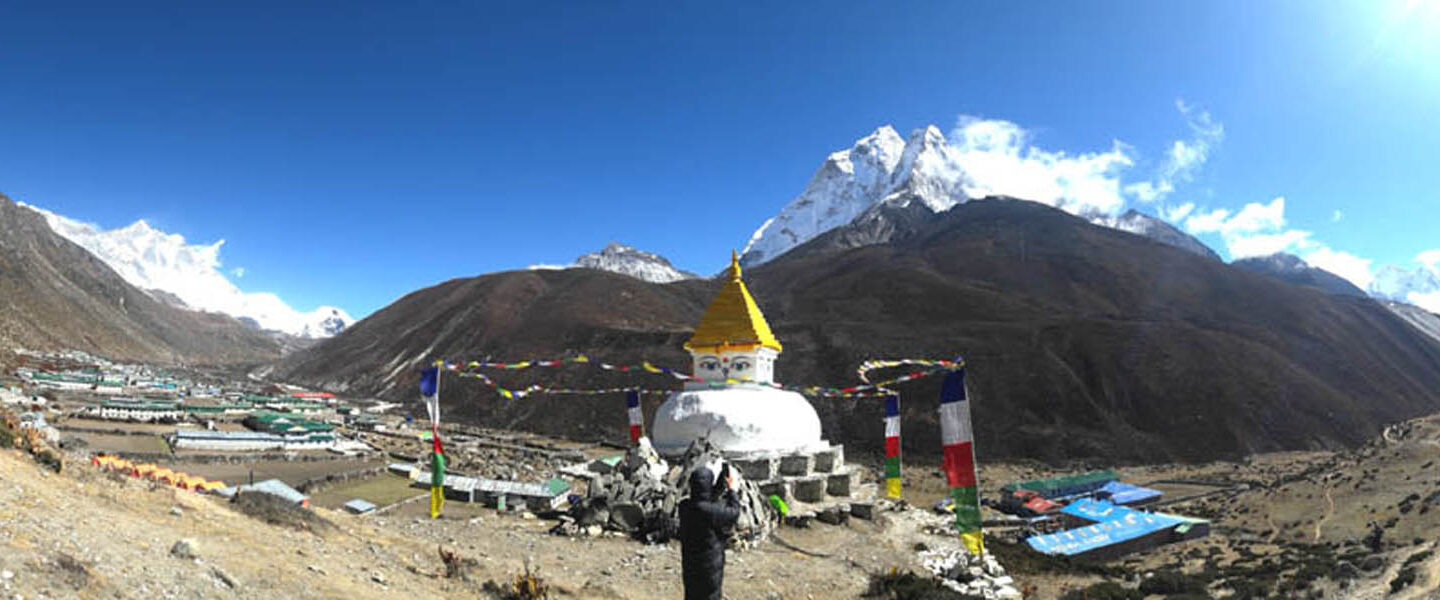
Different kinds of costs make up the total Everest Base Camp trek cost. A lot of people tend to consider just the package cost before they sign up for the journey which makes them face difficulties later in the journey, both financial and otherwise.
There are so many other costs that the trekkers need to consider for instance the cost of transportation, and shopping for clothes, or equipment. Make sure that you properly look into all these areas of expenditure while planning your journey.
Equipment Cost
There is the various necessary equipment that is a must for your trip. These include an all-season sleeping bag and backpacking sleeping bag, a warm and waterproof jacket, mid to light trekking boots and trekking poles, a duffel and daypack, trekking trousers and shirts including a base layer and a second layer fleece, warm gloves including inner and outer layer, and warm thermal socks.
However, depending on the conditions of both, the purpose of your journey, and the circumstances around it, your Everest base camp trek packing list may differ. Fresh equipment may be as expensive as 2000 USD or as cheap as 500 USD. But generally, a total budget of 500 – 1,000 USD is recommended for the equipment cost.
Tour and Accommodations Cost
For a smooth and high-quality experience, it is recommended that you hire a tour operator. A decent tour operator generally costs around 1300 – 1,600 USD. But if you are willing and capable of trekking Everest independently, you can save around 400 – 700 USD.
Transportation by bus will cost around 10 USD while the less-crowded alternative via a private jeep will cost around 200 – 300 USD. A guide will cost you around 25 USD per day which covers the accommodation, food, and insurance. A potter costs around 30 USD. Accommodation includes hotels and lodges that range from 5 – 40 USD.
Travel Permit Cost
For permits, a TIMS card is required which costs from 10 – 20 USD depending on whether or not you are with a local trekking agency. A Sagarmatha National Park entry permit costs around NRs. 3000 while the additional permission of the Gaurishanar Conservation Area Project (Jiri-Everest base camp trek) costs around NRs. 2000.
VISA Cost
Similarly, VISA, insurance, flight costs, and general costs of travel are also factors to be considered. The VISA to Nepal costs 30 USD for 15 days, 50 USD for a 30-day stay, and 125 USD for 90 days. In conclusion, Nepal is in no way an expensive country so you should find your Everest Base Camp trek budget to be quite reasonable.
Travel Insurance Cost
It is also highly recommended that you carry travel insurance as trekking always comes with risks. The basic insurance needs to cover events such as flight cancellation, tour cancellation, and medical costs.
Insurance policies may not cover trips over 4,000 meters, so you must acquire details confirming you are covered for both high altitude and medical air support. The insurance cost varies greatly but on average around 150 USD.
Everest Base Camp Trek Difficulty
Although at first glance, the name of the trek sounds rather daunting, the Everest base camp trek is not as treacherous as it seems. Even though only a few brave souls may venture towards the summit of Mt. Everest, around 30,000 trekkers easily travel to the Everest base camp annually.
The trek itself can easily be simplified as a long hike at a high altitude which requires little technical or mountaineering skills, with days for acclimatization built into the itinerary.
However, achieving a moderate level of fitness still requires a particular emphasis on stamina and leg strength. It is advisable to commence preparations 6 – 8 weeks in advance, focusing on developing leg strength, core fitness, and stamina. Similarly, having a high degree of determination is also important for completing the task.
Everest Base Camp Trek Map
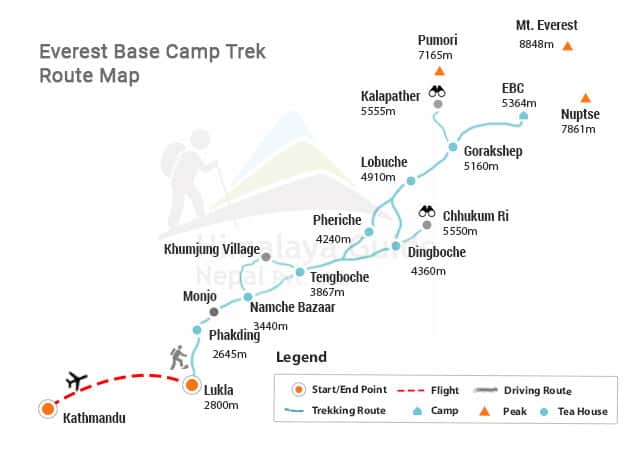
The Everest base camp trek is a complex scenario partly due to the variety of attractions found in the region. So, a general understanding of the area of the visit is important. Unfortunately, time is limited and not all parts can be explored.
Thus selecting the most interesting sites to explore in such a vast area would require an Everest base camp trek map. And with this, you will have the freedom to select your sites of interest, the routes, and side routes, and overall discretion regarding how you wish to conduct your journey.
Making plans, dictating your journey through the area, anticipating the challenges ahead, and deciding whether to face them or take a detour becomes very convenient with the help of an Everest base camp trek map. A similar principle also applies in the case of any of your general visits to Nepal.
Himalaya Guide Nepal Pvt. Ltd. is a registered trekking company with professional guides and porters. We have been working for many years in the tourism industry of Nepal, to organize trekking, peak climbing, expeditions, hiking, tours, air ticketing, hotel reservations, and adventure activities.
When it comes to trekking and expedition, we are a renowned name; however, our packages are quite affordable. We focus on client satisfaction, and to achieve that, we allow our clients to make changes to their itinerary.
If you’re looking to try trekking in Nepal, make sure to choose us as your trekking partner. We give you all a heartfelt welcome from Himalaya Guide Nepal for your secure and unforgettable holiday in Nepal.

